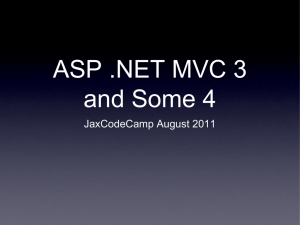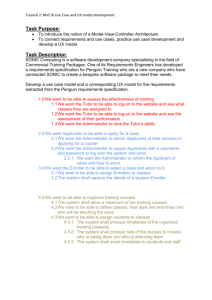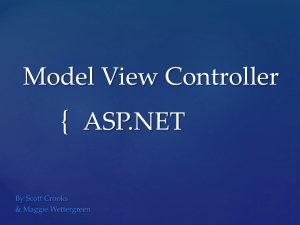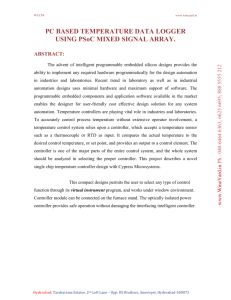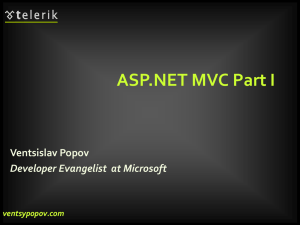ASP .NET MVC 5
advertisement
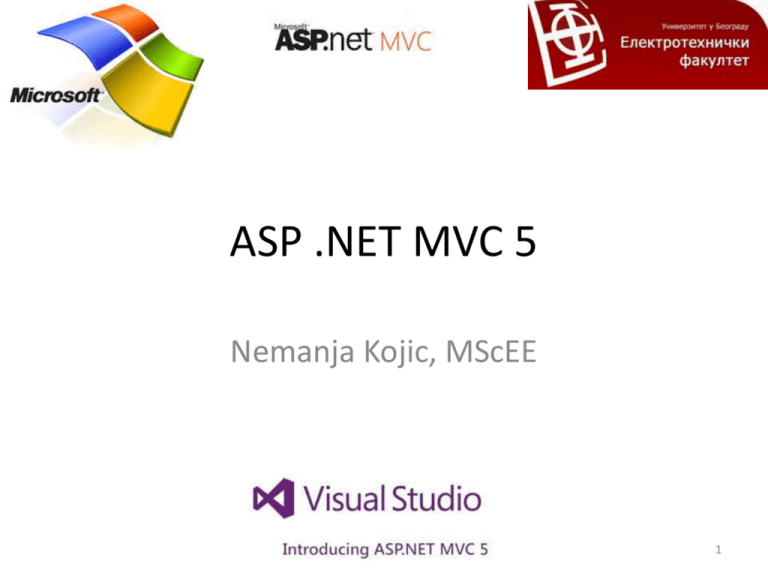
ASP .NET MVC 5
Nemanja Kojic, MScEE
1
What is MVC?
• Model-View-Controller (MVC)
• Standard Architectural Pattern
• Separation of concerns:
model, view, controller
2 of 114
ASP .NET MVC Framework
• An alternative to ASP .NET Web Forms
• Presentation framework
– Lightweight
– Highly testable
– Integrated with the
existing ASP .NET
features:
• Master pages
• Membership-Based
Authentication
• ...
3 of 114
ASP .NET MVC Framework
Components
• Models
– Business/domain logic
– Model objects, retrieve and store model state in a
persistent storage (database).
• Views
– Display application’s UI
– UI created from the model data
• Controllers
– Handle user input and interaction
– Work with model
– Select a view for rendering UI
4 of 114
When to use MVC approach?
• Advantages:
– Easier to manage complexity (divide and conquer)
– It does not use server forms and view state
– Front Controller pattern (rich routing)
– Better support for test-driven development
– Ideal for distributed and large teams
– High degree of control over the application
behavior
5 of 114
ASP .NET MVC Features
• Separation of application tasks
– Input logic, business logic, UI logic
• Support for test-driven development
– Unit testing
– No need to start app server
• Extensible and pluggable framework
– Components easily replaceable or customized
(view engine, URL routing, data serialization,…)
6 of 114
ASP .NET MVC Features (cont.)
• Support for Dependency Injection (DI)
– Injecting objects into a class
– Class doesn’t need to create objects itself
• Support for Inversion of Control (IOC)
– If an object requires another object, the first
should get the second from an outside source
(configuration file)
7 of 114
ASP .NET MVC Features (cont.)
• Extensive support for ASP .NET routing
• Building apps with comprehensible and
searchable URLs
• Customizable URLs
– Adapted to work well with search engines
– Adapted to REST addressing
– Decoupled from resource files
• Use of existing ASP .NET features
(backward compatibility)
8 of 114
ASP .NET MVC App Structure
• URLs mapped to controller classes
• Controller
– handles requests,
– executes appropriate logic and
– calls a View to generate HTML response
• URL routing
– ASP .NET routing engine (flexible mapping)
– Support for defining customized routing rules
– Automatic passing/parsing of parameters
9 of 114
ASP .NET App Structure
• No Postback
interaction!
• All user interactions
routed to a controller
• No view state and
page lifecycle events
10 of 114
MVC App Execution
• Entry points to MVC:
– UrlRoutingModule and MvcRouteHandler
• Request handling:
– Select appropriate controller
– Obtain a specific controller instance
– Call the controller’s Execute method
11 of 114
MVC App Execution - stages
• Receive first request for the application
– Populating RouteTable
•
•
•
•
•
•
Perform routing
Create MVC Request handler
Create controller
Execute controller
Invoke action
Execute result
– ViewResult, RedirectToRouteResult, ContentResult,
FileResult, JsonResult, RedirectResult
12 of 114
MVC App Execution
13 of 114
BUILDING VIEW PAGES USING RAZOR LANGUAGE
RAZOR ENGINE
14 of 114
Razor Engine
• A new view-engine
• Optimized around HTML generation
• Code-focused templating approach
15 of 114
Razor Engine – Design goals
•
•
•
•
•
•
Compact, Expressive and Fluid
Easy to learn
It is not a new language
Works with any text editor
Great Intellisense
Unit-testable
– Testing views without server, controllers…
16 of 114
Razor – HelloWorld
• Uses @ for
Razor blocks
razor file
.aspx file
17 of 114
Loops and Nested HTML
Razor syntax
.aspx syntax
18 of 114
If Blocks and Multi-line Statements
IF statement
Multi-line
statement
Multi-Token
statement
Variables can span
Variables
multiple server
code blocks!
19 of 114
Integrating Content and Code
Parser examines right-hand
side of @ character.
Identifying nested
content with HTML
block tag
20 of 114
Layout/Master page
SiteLayout.cshtml
@RenderBody()
Including specific body content.
21 of 114
Content page
Explicitly setting LayoutPage property.
Complete HTML page.
22 of 114
Master page – section overrides
This section is optional.
This section is optional.
23 of 114
Master page – section overrides
Named section.
Named section.
24 of 114
Master page – result html
25 of 114
Re-usable “HTML Helpers”
• Methods that can be invoked
within code-blocks
• Encapsulate generating HTML
• Implemented using pure code
• Work with Razor engine
Built-in HTML helper
26 of 114
Define own HTML helpers
@helper
declarative syntax
Helper’s parameters (full
language and ebugging support)
HTML Helper definition
HTML Helper should be placed
to Views\Helper directory.
HTML Helper Invocation
27 of 114
Visual Studio support
28 of 114
Razor – Summary
•
•
•
•
•
A good new view engine
Code-focused templating
Fast and expressive
Compact syntax
Integrated with C# and VB
29 of 114
CREATING ASP .NET MVC
APPLICATION
30 of 114
New Project …
31
32 of 114
Select the project template
33
ASP .NET MVC App Home page
34
Run the application…
35
Expand the default App menu
36
ADDING CONTROLLER
37 of 114
Adding controller
38
Adding controller (cont.)
39
Adding a controller (cont.)
40
Testing the controller
41
Mapping controller
• Controller selection based on URL
• Default URL routing logic:
/[Controller]/[ActionName]/[Parameters]
• Format for routing in
App_Start/RouteConfig.cs
42 of 114
URL routing
• Webapp URL without URL segments =>
HomeController::Index()
• Index() – default method of a controller
• /HelloWorld => HelloWorldController
• /HelloWorld/Index =>
HelloWorldController::Index()
• http://webapp:port/HelloWorld/Welcome =>
HelloWorldController::Welcome()
43 of 114
Parameters
• /HelloWorld/Welcome?name=Scott&numtimes=4
• Introducing 2 parameters to Welcome method
• Parameters passed as query strings!
44 of 114
URL Parameters
• http://webapp/HelloWorld/Welcome/3?name=Rick
Parameter ID matches URL specification
in RegisterRoutes method.
45 of 114
ADDING A VIEW
46 of 114
Views
•
•
•
•
Views created using Razor view engine
Controller method returns View object
Controller method return type is ActionResult
Common pattern: all view pages share the
same master layout page
47 of 114
Create View page
48 of 114
Create View page
Master page.
49 of 114
Implementing View page
Selected master page.
Change controller’s method signature.
The method retures a view object:
searches a view file that is named the
same as the method (Index.cshtml).
Index, by default.
50 of 114
ViewBag
• Pass data between view template and
layout view file
• ViewBag is a dynamic object
(has no defined properties)
View template file.
Layout view file.
51 of 114
Passing data from Controller to View
• View is used for data presentation
• Controller must provide a view with the data
• One approach: using ViewBag
– Controller puts data to ViewBag,
– View reads ViewBag and renders the data
– No data binding!
• Alternative approach: the view model
– Strongly typed approach
52 of 114
Passing data from Controller to View
Controller
View
Returns
HelloWorldView
object.
53 of 114
ADDING A MODEL
54 of 114
Model components
• Entity framework - data access technology
• “Code first” development paradigm
(first code classes, then generate DB schema)
• “Database first” development paradigm
define db schema first,
then generate models, controllers and views
55 of 114
Adding a model class
Enter the class name,
e.g. Movie.cs
56 of 114
Adding properties to a model class
57 of 114
Adding a DbContext class
EF namespace
DbContext
DbSet
EF database
context
FETCH,
INSERT,
UPDATE
58 of 114
DB Connection string
Separate connection string
for each DbContex class
59 of 114
Accessing Model from a Controller
60 of 114
Accessing Model from a Controller
Visual Studio Creates:
A controller MoviesController.cs
file in Controllers folder,
Create.cshtml, Delete.cshtml,
Details.cshtml, Index.cshtml in
Views\Movies folder.
Strongly typed
approach.
61 of 114
Run Application…
Notice: default routing
Creates a new movie.
Database is still empty.
Notice: generic column
name, derived from the
model class.
62 of 114
Creating a model object
Automatically generated form,
based on the model info.
63 of 114
Generated Controller class
Instantiated
DbContext instance.
Index method.
64 of 114
Strongly typed models
• MVC provides strongly typed way of passing
data from Controller to View
• Better compile-time checking
• Richer IntelliSense in VS code editor
65 of 114
Strongly typed models
@model: Specifies class of the model
Id parameter generally passed as a part of
the route.
Communicates
with the master
page.
Context-sensitive
data access.
66 of 114
Strongly typed models (cont.)
Index.cshtml
Model object is strongly typed.
Each item is a Movie object.
Full compile-time
support.
67 of 114
Edit View
Localhost:1234/movies/Edit/4
URL generated using Html Helpers!
68 of 114
Edit View (cont.)
Parameter passed through the URL query.
Works for MVC default URL mapping.
Label defined in the
model class.
Date format defined in
the model class.
69 of 114
Edit View
Generates hidden anti-forgery
token.
Generates html label.
Generates text box.
Generates validation message.
70 of 114
Property annotations
Annotations namespace.
Overrides default label name on the view page.
Specifies type of the data: displays only date part.
Workaround for
a bug in Chrome
71 of 114
ActionLink helper
• Html.ActionLink – generates a link according to
a given URL mapping policy
Anonymous object –
specifies ID of an object
• Primer:
Html.ActionLink(“Edit", “Edit", new{id=item.ID)}
Controller action name.
72 of 114
Edit actions
• Implemented as Controller’s operations
HTTP GET operation
HTTP POST operation
Prevents request forgery
[Bind] attribute – a
security mechanism that
prevents over-posting
data to the model.
[HttpGet] annotation by
default.
73 of 114
Processing the POST request
HTTP POST method.
Validates the forgery token.
Checks if sent data are valid – server side validation,
compared to client-side validation (javascript)
Redirects after successful update.
In case of invalid data, the original form is returned
back to the client, displaying error messages
74 of 114
HTTP methods – best practices
• HttpGet and HttpPost method overloads
• All methods that modify data SHOULD use
HttpPost method overload
• Modifying data in HttpGet method
– security risk
– Violates HTTP best practices
– Violates REST architectural pattern
• GET method SHOULD NOT have any side effect
and SHOULD NOT modify persistent data
75 of 114
ADDING SEARCH
76 of 114
Search form – Index.cshtml
Enter a text filtering value.
77 of 114
View/Controller – changes
View (changes)
Controller – changed signature of
the method Index.
LINQ query definition
(NOT execution!)
Default form
method = POST!
Lambda expression
Use overriden BeginForm method
to force HttpGet method.
78 of 114
Searching movies – URL query
HTTP POST
HTTP GET
79 of 114
Adding search by Genre
HttpGet method handles
the request.
80 of 114
Search by Genre – View
Preselected value.
DropDown list markup.
Parameter “movieGenre” is
the key for populating
dropdown list from ViewBag.
81 of 114
Search by Genre – Controller
Populating the
list of genres in
ViewBag.
Key movieGenre is the
same as the parameter
of the dropdown list.
82 of 114
Details method - Controller
83 of 114
Delete method - Controller
HttpGet method.
Selects an objects and
returns Details page.
RULE:
Never use a HttpGet method
to modify the model.
Opens security holes,
architecturally bad!
Asp .net maps a segment of URL
to a method.
Attribute ActionName is
necessary to provide valid URL
routing.
The same URL maps to different
action methods, based on used
HTTP method.
HttpPost method.
Deletes an object
having the given id.
84 of 114
Data Validation
• Keep Things DRY
(Don’t Repeat Yourself)
• Declarative validation rules in one place
(Model class)
–
–
–
–
–
Regular expressions
Range validation
Length validation
NULL values validation
Data formatting
• Validation rules enforced before saving changes
to the database!
85 of 114
Validation rules – Model
Several validation rules failed.
86 of 114
Data Validation - View
Client-side validation: javascript
(jQuery).
Validation rules picked up from the
model class annotations.
Validation messages derived from the
validation constraints in the model
class.
87 of 114
Data Validation – View (cont.)
Validation message derived from the
validation constraints specified for
the given Property (Title)
88 of 114
Data Validation - Controller
HttpGet method displays initial Create form.
HttpPost method that does create a new object.
Server-side data validation check.
89 of 114
DataType attributes
• Provide only hits for the view engine
to format the data
• Date, Time, PhoneNumber, EmailAddress,…
• Automatic provision of type specific features
e.g. “mailto: ...” link for EmailAddress
• Do NOT provide any Validation
(just presentation hints)
90 of 114
DisplayFormat annotation
• Used to explicitly specify format of the data
• Example: redefining the default date format
It is possible to specify validation
properties in one line!
91 of 114
LAMBDA EXPRESSIONS
92 of 114
Introduction
• Expressions that use special syntax
• Anonymous functions used as data
(variables, fields, parameters, return values)
• The anonymous functions are used to create
delegates and expression trees
• Lambda expressions particularly helpful for
writing LINQ queries
• Available from .NET 4.5
93 of 114
Operator =>
•
•
•
•
•
Interpreted as “goes to”
Used for declaring a lambda expression
The same priority as assignment (=)
Right associative operator
Separates the parameters and function body
Left side
=>
Right side
An Empty parameter list
An expression
A formal parameter list
A Statement list inside curly brackects.
An implicit parameter list
94 of 114
Anonymous functions
•
•
•
•
Inline statements or expressions
Used wherever a delegate type is expected
It can initialize a named delegete
It can be passed as the parameter where
a named delegate type is expected
• Two kinds of anonymous functions
– Anonymous methods
– Lambda expressions
95 of 114
Evolution of delegates in C#
Named method
Inline code
(anonymous method)
Lambda expression
96 of 114
Anonymous method
• No name, no overloading
• Created using the delegate keyword
• It is possible to add multiple statements
inside its body
97 of 114
Anonymous method (cont.)
• Scope of the parameters is the anonymous
method block
• No jump from inside an anonymous method
block to the outside, and vice versa.
• Cannot access ref and out parameters of an
outer scope
• No unsafe code access inside its block
• Not allowed on the left side of the operator
is.
98 of 114
Expression lambdas
• Lambda expression with an expression on the
right side of the operator =>
• Used dominantly in construction of
expression trees
• (input parameters) => expression
• Parentheses optional if lambda has one param.
• Input parameters separated by comma
99 of 114
Expression lambdas - examples
• (x, y) => x == y
The parameters types inferred by the compiler
• (int x, string s) => s.Length > x
Specify types of the parameters when the compiler
cannot inferre them from the code.
• () => SomeMethod()
Zero input parameters specified with empty
parentheses.
Note: a method call cannot be evaluated outside
the .NET Framework (e.g. SQL Server)
100 of 114
Statement lambdas
• (input parameters) => {statement;}
• Statements enclosed in braces
• The body of a statement lambda can contain
multiple statements (in practices, two-three)
• Cannot be used to create expression trees
101 of 114
Generic delegates – Func
• System.Func<T,TResult>
T – argument type,
TResult – return type (last type parameter)
• Useful for encapsulating user-defined
expressions that are applied to all elements of
a data set
A generic declaration of the delegate Func.
Example of usage.
102 of 114
Func delegate (cont.)
• A lambda expression can be passed where
Expression<Func> type is required
– System.Linq.Queryable
Output: 5, 1, 3, 9, 7
Compiler can infere the
type of the parameter n.
Output: 5, 4, 1, 3
Output: 5, 4
103 of 114
Type inference in lambdas
• Compiler can infer the type of the parameters
based on:
– Lambda’s body
– Parameter’s delegate type
• Example:
IEnumerable<Customer> customers=...
Standard query operator.
104 of 114
Lambda expressions – general rules
• The lambda must contain the same number of
parameters as the delegate type
• Each input parameter in the lambda must be
implicitly convertible to its corresponding
delegate parameter
• The return value of the lambda (if any) must
be implicitly convertible to the delegate’s
return type
105 of 114
Lambda expressions - examples
•
•
•
•
•
•
Func<int,int> f1 = x => x+1;
Func<int,int> f2 = x => {return x+1;}
Func<int,int> f3 = (int x) => x +1;
Func<int,int> f4 = (int x) => {return x+1;}
Func<int,int> f7 = delegate(int x) {return x+1;}
Invocation example:
Console.Writeln(f1.Invoke(4));
106 of 114
Lambda expressions - examples
• Func<int,int,int> f5= (x,y) => x*y
Invocation: Console.Writeln(f5.Invoke(2,2));
• Action f6 = () => Console.Writeline();
Function instance that does not receive any
parameter nor returns value.
Invocation: f6.Invoke();
• Func<int> f8 = delegate { return 1+1;}
Invocation: Console.Writeln(f8());
107 of 114
Language Integrated Query
LINQ
108 of 114
Content
•
•
•
•
Undestand what LINQ is?
Learn what problems solves
See what its syntax looks like
Know where LINQ can be used
109 of 114
What is LINQ?
•
•
•
•
•
Language INtegrated Query
It is part of programming language syntax
Supported by: C#, VB, Delphi Prism
Used for querying data
Supported the following types of data sources
– Relational data
– XML data
– objects
110 of 114
LINQ Architecture
111 of 114
ADO .NET vs. LINQ
ADO .NET
• OO library for relational
data access
• Mapping from relational to
OO objects needed!
• High Impedance Missmatch
for mapping data from
storage to objects in an
application
LINQ
• SQL-Like syntax that deals
with pure objects
• Reduces the Impedance
Missmatch
• Makes data querying more
efficient
• One still must know the
format of the data
112
LINQ Adapters
•
•
•
•
•
LINQ to Objects
LINQ to SQL
LINQ to XML
LINQ to Entities
It is possible to create own customized adapter
– E.g. LINQ for Querying Twitter API
113 of 114
References
• ASP .NET MVC 5 Tutorial – Official
http://www.asp.net/mvc/tutorials/mvc5/introduction/getting-started
• Lambda expressions
http://www.dotnetperls.com/lambda
• LINQ
http://code.msdn.microsoft.com/101-LINQSamples-3fb9811b
114 of 114
